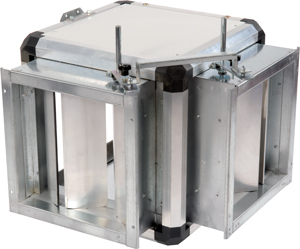- Fresh air intake and discharge grills
They protect against the rain and due to a metallic grill, against birds and vermin.

Source Trox
- Dampers

Dampers
are situated at the AHU intake. Opening and closing are linked to fan
operation.
Dampers are controlled by servo-motors (rotary or
linear).

Rotary servo-motor Linear servo motor – Source Belino
- Mixing plenums
A set of 2 or 3 dampers controls the flow of fresh, exhaust and recirculated air. Together this makes up a (mixing) plenum.

Dampers of a plenum permit:
- Isolation of the AHU when switched off.
- The control of fresh air and recirculated air flows.
- Anti-frost protection of the heating coil in case of problems (the closing of the dampers is controlled by an anti-frost thermostat).
-
Energy
recovery (« free cooling »).
Free cooling is the maximum intake of fresh air flow in mid-season while the outside temperature is favourable to ambient cooling. For this, the dampers are automatically controlled to increase the fresh air flow and then to reduce it when the outside temperature increases or becomes too low.
Question
Indicate the position of the dampers (open O or closed C) in the AHU below when operating on 100% fresh air.
Show with arrows the sense of air distribution in the fed ducts, dampers and rooms.

Note:
This operating situation « 100% fresh air », in which the return network does nothing, corresponds to a maximum input of fresh air due to an excessive occupation of the rooms or a control setting of « free cooling » type, while the outside temperature is favorable.
This situation must be combined with speed variations on the extracting elements. During unoccupied periods, the AHU could be switched to integral recirculation. The extraction elements are thus switched off or at low speed, except in the sanitary facilities.
Question
Indicate the position of the dampers (open O or closed C) in the AHU below when operating on 100% recirculation.
The extraction in the ‘circulation’ (lobby) is off.
Show with arrows the direction of air distribution in the fed ducts, dampers and rooms.
What happens in the sanitary facilities where air extraction is generally maintained?

The sanitary facilities are in depression.
Question
– Show below the direction of air distribution and the flows in circulation in all the ducts of the system.
– The initial situation being that of the preceding exercise (100% recirculation). What movements have the plenum dampers made? What is therefore, roughly, their position?

Recirculation = blower flow – Fresh air flow
= 10,000 – 7,500 = 2,500 [m3/h] (85,000 ft3/h) Exhaust flow = fresh air flow
= 7,500 [m3/h] (265,000 ft3/h) In the initial situation (100% recirculation), the fresh air damper was closed and the recirculating air damper was fully open.
The change to the present situation has led to:
– The partial opening of the fresh air damper (« ¾ » open)
– The partial closing of the recirculation damper (« ¾ » closed). Note that the fresh air damper has an opposite operation to the recirculation damper.
They work in opposition.



